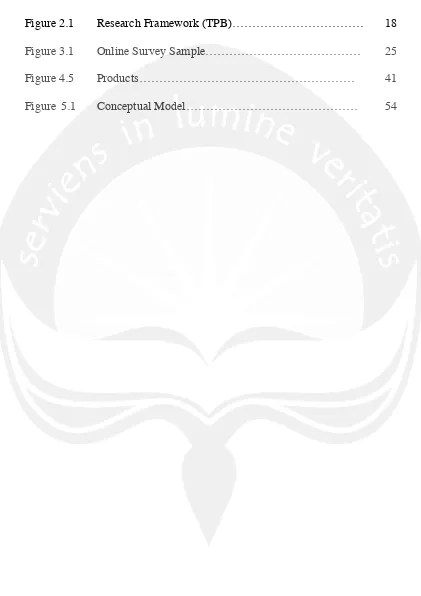Bargaining Behavior of Young Chinese Customers
in D. I. Yogyakarta
THESIS
Presented as Partial Fulfillment of the Requirements for the Degree of Sarjana Ekonomi (S1) in International Business and Management Program,
Atma Jaya Yogyakarta University
Compiled by: Felicia
Student ID Number: 11 12 18882
FACULTY OF ECONOMICS
v
problems. We pour our emotions and thoughts to solve the problems. I always try
hard to think positive and optimistic because if I look for bad, I will always find
it, and if I look for the good, I will find that too. Our experience of humanity and
life itself is truly up to us. And, my writing thesis experience is also one of great
lessons for me to be more humble, wiser and high-minded.
I am always proud of being one of UAJY’s international students. In this
great experiences that I could not mention while I was studying in this university.
Time flies so fast, I am thankful that I could manage and use my time well for
studying and making friends. And, I believe Universitas Atma Jaya will grant
your wishes whenever you ask and need help.
Thanks to Mr. Jaktu and Mrs. Evian who gave me born and grow me up till
vii
1.6Potential Academic Contribution………. 7
1.7Thesis Structure……….... 8
CHAPTER 2: LITERATURE REVIEW……… 10
2.1 Introduction………... 10
2.2 Bargaining ………... 10
2.3 Previous Research………. 11
2.4 Cultural Notes on Chinese Negotiating Culture………….... 13
viii
2.6 Hypotheses Development………. 17
2.6.1 Attitudes………... 19
2.6.2 Subjective Norms………. 19
2.6.3 Perceived Behavioral Control……….. 20
2.6.4 Bargaining Intention………... 21
CHAPTER 3: RESEARCH METHODOLOGY……….. 22
3.1 Introduction……….. 22
3.2 Research Design………... 22
3.2.1 Research Method……… 22
3.2.1.1 Previous Research Method……… 22
3.2.1.2 Current Study Method……… 23
3.2.2 Research Context……… 26
3.3 Populations and Sampling……… 27
3.4 Research Procedure……….. 28
3.4.1 Research Variables……… 28
3.4.2 Data Collection Method……… 28
3.4.3 Data Analysis Technique……….. 29
CHAPTER 4: DATA ANALYSIS AND INTERPRETATION…… 31
4.1 Introduction……….. 31
4.2 Response Rate……….. 31
4.3 Reliability and Validity Analysis………. 32
4.3.1 Reliability Analysis……… 32
4.3.2 Validity Analysis……… 33
4.4 Profile of Respondents……….. 35
4.4.1 Age………. 35
ix
4.4.3 Educational Level……… 36
4.4.4 Monthly Pocket Money/Income……….. 37
4.4.5 Bargaining Intensity………. 39
4.4.7 Products……… 39
4.5 Correlation Analysis……… 42
4.6 Attitudes, Subjective Norms, PBC, & Bargaining Intention 43 4.7 The Relation between PBC and Bargaining Behavior…… 48
4.8 The Relation between Intention and Bargaining Behavior.. 49
4.9 Comparison between Previous and Present Research……. 50
CHAPTER 5: CONCLUSIONS & MANAGERIAL IMPLICATION 52 5.1 Introduction………. 52
5.2 Conclusions………. 52
5.3 Managerial Implication………... 54
5.4 Research Limitation……… 55
5.5 Suggestions………. 56
x LIST OF TABLES
Table 2.1 Study Comparison……….. 11
Table 3.1 Descriptions of Measure Items………... 28
Table 4.1 Reliability Analysis……… 32
Table 4.2 Validity Analysis……… 34
Table 4.3 Age………. 35
Table 4.4 Gender……… 36
Table 4.5 Educational Level……….. 37
Table 4.6 Pocket Money or Income………... 38
Table 4.7 Bargaining Intensity……….. 39
Table 4.8 Products………. 39
Table 4.9 Correlation Analysis………. 42
Table 4.10 Regression Analysis of Attitude-Intention………….. 43
Table 4.11 One Sample T-Test of Attitude……… 44
Table 4.12 Regression Analysis of Sujective Norm-Intention…. 44 Table 4.13 One Sample T-Test of Subjective Norm……….. 45
Table 4.14 Regression Analysis of PBC-Intention………. 46
Table 4.15 One Sample T-Test Analysis of PBC……….. 47
Table 4.16 Regression Analysis for PBC……….. 48
Table 4.17 One Sample T-Test of Bargaining Intention………… 49
Table 4.18 Regression Analysis for Bargaining Intention………. 50
xi LIST OF FIGURES
Figure 2.1 Research Framework (TPB)……… 18
Figure 3.1 Online Survey Sample……… 25
Figure 4.5 Products……… 41
xii LIST OF APPENDIXES
Appendix 1: Questions of the Research (English and Indonesian)
Appendix 2: Data of Respondents of Questionnaire
Appendix 3: Reliability and Validity Analysis Using SPSS 22
Appendix 4: Descriptive Analysis of Respondents Using SPSS 22
Appendix 5: Correlation Analysis of Variables Using SPSS 22
Appendix 6: One-Sample T-Test Using SPSS 22
xiii BARGAINING BEHAVIOR OF YOUNG CHINESE CUSTOMERS
IN D. I. YOGYAKARTA
Compiled by Felicia
Student ID Number : 111218882
Supervisors Gunawan Jiwanto, Drs., MBA.
ABSTRACT
This research examines the bargaining behavior of young Chinese
customers in Indonesia, especially in D. I. Yogyakarta. This research replicated
from previous research by Lee, Don Y (2000), “Retail Bargaining Behaviour of
American and Chinese Customers”, using the Theory of Planned Behavior by
Fishbein and Ajzen. Total respondents are 175 Chinese students. The data
collection was gathered by using convenience sampling and targeted to high
school students or university students in Yogyakarta. Simple regression analysis
was used to analyze the data.
The result of this study shows that attitudes, subjective norms, and
perceived behavioral control positively affect the bargaining intention. Young
Chinese customers in Indonesia are considered as competitive bargainer.
Keyword: Bargaining Behavior, Bargaining Intention, Attitudes, Subjective
